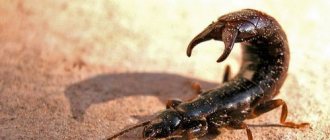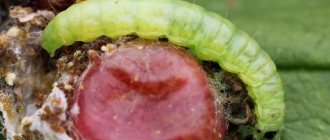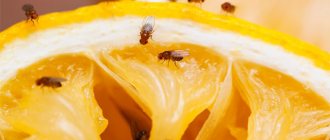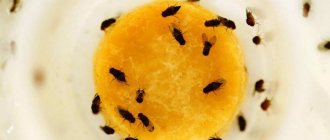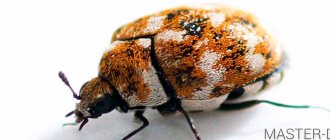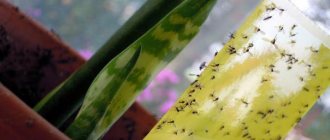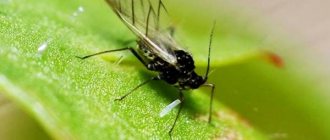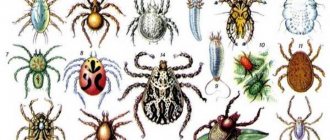Various pests strive to live next to humans: these are cockroaches, bedbugs, moths, and ants. This list can also include midges - small insects of the Diptera family. Science knows more than 1000 varieties of midges. There are black and green midges, whiteflies, and thrips. The flower midge is a pest of indoor plants; there is also a species that annoys animals; house flies living in apartments bite, spreading dangerous infections, especially when biting in the eye. And given the fact that, unlike mosquitoes, they swarm in a whole cloud, an insect attack can have very negative consequences.
About house midges
Midges can appear even in the apartment of the cleanest housewife. So one of its very common representatives are Drosophila - these are small insects, about 2 mm, that live in spoiled fruits or vegetables. It is with these products, purchased at the market or in a store, that pests most often enter the house. Drosophila do not pose a particular danger to humans, but they become one of the main enemies of garden and vegetable fruits. The appearance of such midges in flower pots with orchids and other plants is evidence of excessive watering of the flower.
The question of whether midges bite is puzzled by those who once discovered various kinds of rashes on the skin, accompanied by itching, burning, pain and swelling. It may seem strange to many, but there are also midges that can bite.
However, pests do not bite at night, as bed bugs do, but are active during the daytime. That's why they don't start in bed or bed.
Biting midges prefer damp places in the apartment, therefore, accumulations of adult individuals can often be found in the drain holes of sinks, as well as in the soil of indoor plants. They can enter the room through the ventilation system or fly in through a window from the street.
Black midges are much larger than fruit flies, their body length reaches up to 6 mm. Outwardly, they are very similar to flies; they can be house flies or earth flies. Pests do not dig into the skin with their stings like other insects, but gnaw out a piece of flesh, in place of which small wounds form. During an attack, the biting midge injects an anesthetic liquid. That is why the pain from a bite is not felt immediately, but after some time.
Saliva that gets into the wound often causes an allergic reaction. Multiple bites made by biting midges may be accompanied by fever, rapid heartbeat and enlarged lymph nodes.
What not to do after a bite
The itching caused by midge venom is so severe that even an adult finds it difficult to resist scratching the skin. And what can we say about kids, who find it difficult to explain the danger of the current situation. When scratching, wounds and microcracks appear, into which pathogenic bacteria easily penetrate. After a few days, ulcers and suppuration may join the symptoms of an allergic reaction. Therefore, dermatologists in the treatment of edema in children focus specifically on eliminating skin itching. What else is strictly forbidden to do after being bitten by midges:
- to take a bath;
- apply decorative or caring cosmetics to unaffected areas of the skin;
- self-medicate;
- Apply menthol ointment to open wounds.
At the healing stage of damaged skin, it should not be treated with solutions containing aggressive chemicals. These drugs include external agents containing ethyl alcohol.
Warning: If the wound is suspected of becoming infected and pathogenic microorganisms have entered the bloodstream, the doctor prescribes drugs with antibacterial activity in the form of tablets or suspensions. You should not ignore the doctor’s recommendations and not take such medications. Pathogenic bacteria can cause severe infectious diseases
How to deal with biting midges in an apartment
Fighting midges at home
- Biting midges will not annoy apartment dwellers if you do not leave unsanitary conditions in the kitchen overnight: food on the table, dirty dishes in the sink, and waste in the trash can. After all, it is the smell of rot that attracts the attention of insects.
- In the kitchen, you should sort through and get rid of dirty bags and containers in which food was previously stored. It is advisable to treat the internal and external surfaces of cabinets with a vinegar solution, since midges are very afraid of its smell.
- Biting pests will not be able to fly into the apartment through the window or enter the room through the ventilation if they are protected by mosquito nets.
- If necessary, drain pipes under the kitchen sink should be cleaned, as food debris and moisture are the most favorable conditions for the spread of green midges.
- It is necessary to pay attention to indoor plants by adjusting their watering. You should also periodically loosen the soil and use drainage.
- Sticky tapes and traps that hang in places where they accumulate will help clean your apartment from biting midges.
- Pet cages also require regular cleaning. There is no need to leave stale fruits and vegetables in it.
- To prevent the midge from biting, you can catch it with a vacuum cleaner, subsequently cleaning the dust container outside.
- Folk remedies that have a pronounced aroma are also used against biting midges, which are usually found in every apartment. These can be garlic, horseradish, orange or clove sticks.
23.05.2019
How to get rid of midges that bite? - every housewife has asked this question at least once. Midges themselves are very small and difficult to detect immediately. But when they begin to bring discomfort into a person’s life, they should be gotten rid of immediately. Now there are enough chemicals and various methods with which it is easy to get rid of them.
A small insect can bite a person painfully
Reasons for appearance
The fruit is just starting to deteriorate, and the insects are right there. Where do fruit midges come from when the rotting process begins:
- from kitchen trash cans, where they live in plant debris;
- from bathrooms with forgotten wet rags;
- from places where pets are located if their hygiene is not observed;
- from flower pots, over-watered, with rotting roots;
- from ventilation systems if neighbors violate sanitary standards;
- from the basement.
They multiply en masse in such places, waiting for the opportune moment of decomposition of plant tissue to occupy the fruit. But, let’s say, the apartment is in perfect order and everything is fine with ventilation, but if you forget the damaged object on the table, the insects appear.
How do midges form on fruit in this case? This is explained by the peculiarities of their reproduction process. Drosdophila is constantly engaged in laying eggs, which are not visible to the human eye due to their microscopic size. She does this on a still whole, healthy fruit.
As soon as it begins to rot, the process of reproduction of individuals begins, which occurs very quickly (in 24 hours) and begins exclusively with putrefactive changes. The rest of the midges that live nearby join in on the “feast” and lay new eggs, increasing their numbers.
Biting midges and methods of dealing with them
Midges belong to the family of dipterous insects. They reach about 6 millimeters in size. Outwardly they are very similar to flies, only smaller in size. The lifespan of these insects is no more than 1 month. Some midges cause harm to the human body. They carry various types of diseases. Their bite is much more painful and harmful than a mosquito bite, since the midge damages the surface of the skin. A person scratching a bite site can contract a disease such as simulidotoxicosis. These insects prefer damp places, so clusters of midges can be found in drains, sinks, and in the soil of indoor plants. They can appear in an apartment by flying through a window from the street or climbing up an exhaust pipe.
Why do midges appear in flowers?
No pests arise without a reason. The flower midge is no exception. Why did Sciarid's Fly suddenly appear in your plants? There may be several reasons for this.
- Dried leaves of a plant that have fallen into a pot. In this case, after some time the process of rotting begins, and the midges feed on the rot. This will be an ideal environment for them, and their appearance will not be long in coming;
- Increased soil moisture. Perhaps you are watering your plant too much and too often, and the soil simply does not have time to dry out. The water stagnates, and as a result, a humid environment is created around the flower, which flower midges love so much;
- Improper fertilization and feeding of plants. You may be using fertilizers that cause rotting processes. This is, for example, humus or organic fertilizers. The best thing for plants is mineral fertilizers;
- Lack of fresh air. If the room where the plants are located is rarely ventilated or not ventilated at all, then air stagnation occurs. Because of this, moisture will stop evaporating from the soil, and these, as we already know, are the most favorable conditions for the appearance of midges;
- Contaminated soil. It often happens that to plant plants, people use soil from the garden, which may already be infected with flower fly larvae. But often purchased soil contains eggs of these insects. In this case, midges will appear shortly after planting;
- Infected neighbors. Chances are your flowers don't stand alone. Infection of one plant, as a rule, will lead to the fact that midges will begin to “attack” all plants located next to each other, and not just the one they chose in the first place.
Blood-sucking bugs
Blood-sucking bedbugs are the only insects listed here that literally live in beds, sofas, bedding, and the folds of mattresses and pillows.
- The size of bedbugs most often varies between 5–7 millimeters, the bodies of females are rounded, those of males are more elongated, the color is brown, copper, or reddish-brown.
- The larvae look like smaller versions of adult bedbugs, but are lighter in color and smaller in size.
- Bed bugs leave behind a brown, corrosive dirt that is easy to find in places where insects accumulate.
- Bite marks look like swollen red dots, which always appear in several pieces and line up in a chain.
- When bugs puncture the skin, they inject an anesthetic into it, so the moment of the bite may not be felt; in larvae, this body system is underdeveloped, so their bites, on the contrary, can be painful.
Eliminating symptoms
In a typical process, the sequence of changes is as follows: insect bite – rash – itching – scratching – infection – formation of a wound with an inflammatory process on the skin. A similar sequence of measures must be followed during therapy. Let's see what to do if you have allergies, itching, redness and swelling if you are bitten by midges.
Pain and burning
To eliminate pain and burning, the following algorithm should be used:
- We wash the top layer of the skin. filtered water with regular laundry soap;
- Dry the skin without rubbing.
- Press the affected areas with your fingers for 3-5 minutes.
- We treat with an antiseptic (water or alcohol).
- We drink an anesthetic and antiallergic drug.
Itching
If, due to itching after an attack, the victim begins to scratch the damaged area on the skin, the dermis is additionally subjected to trauma and inflammation, and infection penetrates into the wounds. This significantly aggravates the situation, so you need to know what to anoint such places with.
Here is information on how to treat, how to relieve itching and spots after the lesion. We eliminate discomfort with the help of effective folk remedies in the absence of contraindications:
- Onion porridge.
- Toothpaste with menthol.
- Compress made from mashed potatoes.
- Thick foam from laundry soap.
- Compress of crushed dandelion leaves, plantain, peppermint.
- Chatter on water with validol, vodka and vinegar. Add 1 tbsp to a glass of water. l. vodka and vinegar, and then 2 crushed validol tablets.
Rashes
Let's figure out what to smear the place with. There are effective remedies and compresses, but before that you need to take important steps:
- apply baking soda compresses to the affected area;
- use antihistamines;
- anoint the bite site with “Bepanten” or “Golden Star” balm.
Before using the ointment, like any other remedy for the treatment of gnat bites, you need to carefully study the contraindications.
Fleas
A person can be bitten by several types of fleas
and all of them are carriers of parasites and various diseases, from helminthiases to plague, borreliosis and various types of typhus.
- The size of fleas living in the Central region of Russia usually varies between 0.5–3 millimeters, so the insects look mostly like dark moving dots.
- A flea bite always feels like a sharp, burning pain at the site of the skin puncture.
- A small, hard, dried drop of blood may remain at the site of the bite.
- Insects are not particularly scrupulous in choosing a place on the body to feed on, so they can bite in any open areas of the skin.
- The flea bite begins to itch instantly and itch severely for several days.
Fleas do not tend to gather en masse to nest in a specific place, so they can live scatteredly anywhere in the house, not necessarily in or near the bed. If you suspect that it is fleas that are biting you, they live throughout the room.
Helpful advice
Lice
provoke the development of pediculosis and can be carriers of typhus and relapsing fever.
- Depending on the type of lice, the length of their light, oblong or round bodies can range from 1 to 4 millimeters.
- Most lice live directly on a person and constantly feed on his blood; body lice can live in things or a room, but not very far from the food source - a person.
- Lice bites are not felt, but after some time, which depends on the individual characteristics of the body, they begin to itch.
- If there are a large number of pests, their bites may merge into single red spots on the skin and become covered with a white flaky crust.
If you suspect that there are lice at home, you should start looking for them not from the bed or room, but from your own body. Insects can live on the head, eyebrows, mustache, armpits, groin, any place where hair is longer than 2-3 millimeters. Body lice can also be found on fleecy fabrics, which are similar in structure to hair.
Preventive measures
So that you don’t have to look for ways to deal with annoying flower midges, prevent their appearance. If you follow basic care rules, you won’t have to meet these insects:
- Follow the watering schedule. Then the soil will not be waterlogged. Plants need to be watered when the soil dries 1–2 cm.
- Loosen the soil a day after watering.
- Remove fallen leaves and flowers in a timely manner to prevent rotting.
- Calcinate new soil even if the supplier has already proven itself to be good.
- Use a high-quality fertilizer suitable for the specific plant type. Read the instructions so you don't pour too much.
- Use drainage.
- Ventilate the room with flowers.
The appearance of midges in flowers is a sign that the plants need help. Give them some time and they will thank you with a pleasant atmosphere in the house.
Midges
Midges in the house can be understood as pests that, according to the official scientific classification, belong to this family
, and in general small flying insects, the species of which cannot be determined by eye.
- Carnivorous midges can either tear out pieces of skin and feed on them, or drink blood.
- The skin reaction to a midge bite can be different and depends on the type of parasite; sometimes it can be a rounded red micro-abrasion that does not cause any sensation, sometimes it can be intense redness, itching and swelling of the skin several centimeters in diameter around the site of damage.
- , the bite of midges
in the Central region of Russia is not felt by humans. - You don’t need to look specifically for midges; if they are found in your home, you can easily notice them swarming or flying near the food that interests them.
Not all midges bite; many of them feed on indoor plants, microflora growing in damp places at home, your food and pet food. These types of midges can and should also be combated.
Recommended Links
How to treat the consequences of bites
They react to a midge bite in different ways. The most annoying thing is itching, which leads to scratching and the appearance of microscopic lesions on the skin where the infection gets. After this, purulent inflammation has to be treated. Swelling in itself is not painful, but if it does not go away for a long time, occupies a large area or is located near the lips, eyes, or in the neck, then it interferes with normal life activities.
After a midge bite, it is necessary to begin treatment immediately to relieve the itching sensation and stop the spread of toxins.
How to proceed:
- rinse the skin with water, wipe dry;
- cool with ice, wrapping it in a bandage, towel, or some cold object;
- press the bite area with your palm and bandage;
- to treat a bite, you can use an alcohol-containing substance, chlorhexidine, Miramistin, hydrogen peroxide, furatsilin solution;
- relieve pain with paracetamol, Claritin, Diazolin;
- if rashes appear, then lubricate with Fenistil, Cynovit, Hyoxysone, Prednisolone;
- lotions with soda solution (1 tsp + 200 ml of warm water) relieve itching or reduce its manifestations.
Note! If a midge has bitten a child, you need to be especially careful, because they experience pain, swelling and itching are more pronounced, and even a single bite is dangerous. Hormonal drugs cannot be used; it is recommended to use Fenistil-gel, Zvezdochka balm, and Gvozdika cologne.
The skin itches for a long time, this interferes with sleep and work, and pain appears at the site of scratching. To prevent this, you can apply novocaine (0.5% solution), alcohol (1:2) dressings. Soothes with a light massage, stroking, patting with fingertips after lubrication with Menovazine or other products with menthol.
Bite infection
If the itching does not go away for a long time, purulent discharge may appear at the site of scratching - this means that dirt has been brought into the wound and putrefactive processes have begun to develop. At the first signs of discharge, it is necessary to begin therapeutic measures so that the process does not lead to deeper tissue damage:
- Wash the damaged skin well with soap and water;
- thoroughly treat with chlorhexidine, Decasan, hydrogen peroxide;
- apply an ointment that stops the development of a bacterial infection (Levomekol, Oflokain, Synthomycin Liniment, Levosin), bandage it;
- when the wound begins to heal, apply a bandage with Bepanten, Dexpanthenol, Panthenol, Actovegin, Methyluracil, Solcoseryl.
If the healing process is delayed, then medical assistance is necessary. Sometimes it is necessary to treat with antibiotics and clean the wound.
How to treat swelling
Swelling of soft tissues is one of the manifestations of the action of toxins. The swelling may occupy a small area, or it may begin to affect nearby areas.
Measures to relieve swelling after a midge bite:
- exposure to cold (ice, chilled metal);
- apply a bandage, squeeze the surface with your fingers;
- use alcohol (1:1 solution) and salt lotions (1 tsp + glass of water);
- rub with boric alcohol;
- apply ointments that relieve swelling (Hydrocortisone, Sinaflan, Trimistin, Triderm, Kremgen);
- for severe swelling, take Tavegil, Loratadine, Diazolin, Escinat, Furosemide, Manit.
Important! Particular attention should be paid to swelling in the respiratory area. If it grows quickly, then you need to provide access to fresh air to the victim and call a doctor. Such swelling should be treated by a specialist.
Such swelling should be treated by a specialist.
Bite in the eye
Its small size allows the insect to crawl under clothing, into the ear, and sometimes it gets into the eye and causes a bite. The delicate skin around the eye instantly swells, begins to itch, and if prone to allergies, becomes inflamed. If the treatment is applied incorrectly, complications may arise, so consultation with a specialist is required.
First aid:
- Rinse the skin and mucous membranes with cold running water;
- take an antihistamine;
- lubricate the eyelids with Hydrocortisone, Dexamethasone;
- make a compress from cotton wool with parsley juice and green tea infusion;
- Apply a compress with a soda solution (1 tsp + glass of water) to the swelling;
- try not to scratch near the eye, so as not to provoke infection by scratching.
Mosquitoes
Mosquitoes are a whole family of insects that feed on blood. They can enter your home through open windows and vents, through ventilation or drainage systems and are one of the most common pests in the warm season.
- Mosquitoes have dark gray bodies, up to 1 centimeter in length, and transparent wings located parallel to the body.
- Insects emit a characteristic monotonous squeak during flight, which is easy to hear if the parasite is hovering around your head.
- Mosquito bites are sometimes felt, sometimes not, it all depends on the individual sensitivity of the skin and where your attention is directed - most often, if people are passionate or busy with something, the moment of the bite goes unnoticed.
- The bite itself looks like redness that is dense to the touch, itches, and sometimes there is a small swelling around it, but in most cases it goes away after 1–4 hours.
Mosquitoes breed in water and places with high humidity, so they cannot literally live in your bed, however, it is more convenient for them to feed on your blood precisely while you are sleeping, so bites are often discovered in the morning.
Library | Articles
Nature of Western Siberia. North KhMAO-Yugra
Vampires of the insect world
...In the morning - the first frost. The first frosts in the north of the Khanty-Mansiysk Autonomous Okrug are not uncommon already at the end of August. The awakened sun quickly warms the forest. Beautiful! But along with the sun, clouds of midges and biting midges rise into the air. They are worse than mosquitoes! - small, almost invisible.
The midge can still be seen - this bloodsucker reaches a size of one millimeter, and when it drinks human or dog blood, it swells. The midge is even angrier, even smaller - an almost invisible dot with tiny shiny transparent wings; in tenths of a millimeter; crawls into any cracks in gauze curtains, gets hidden under clothes: you can only detect it by the pain from the bite - you can swat it - and then there’s no one! The most sensitive finger does not feel it - so insignificant is the blood-sucking insect. The monster insect was nicknamed the midge because of its “love” for damp wetlands.
Midges appear in large numbers at the end of summer, when the nights become cool and the days become warm; especially activated after the first frost; mosquitoes “move away” at that time (they love warm, humid weather). The midge lives until the end of October. Even when the first snow falls, on the sunny slopes, where the snow melts during the day, the warmed midge begins to fly and, naturally, bite, although not as fiercely as in September and August.
The venom of bloodsuckers is incredibly strong! In an insignificant volume, hardly exceeding a thousandth of a milligram, it causes a lot of trouble even to healthy people and animals. - What would happen if there was a little more of it, and a larger insect?!.. - A gram of such poison could probably kill an elephant!.. It was not for nothing that in ancient times they dealt with unwanted people by simply tying them to a tree in the forest. Man died not from wild animals, as is told in Russian fairy tales, but from vile creatures. Execution by vile beings was considered very cruel, exquisitely painful and at the same time, simply simple in execution. In our summer-autumn taiga, for a lost person, the greatest danger lies not in hunger, hypothermia, bears, wolves, and as is often described in the media - in the lack of water, but in midges.
Merciless insects are the vampires of the animal world, capable of driving all living things crazy, and quickly! After a couple of hours of war with bloodsuckers, even when protected with anti-nasal drugs, nervousness appears: trembling, chills, irritability, turning into an uncontrollable panic desire to run away without looking back. Being not protected by saving ointments, smoke smokers, a person loses control over his mind and is ready to rush anywhere just to get rid of the pursuing vampires - the most bloodthirsty “beasts” of the taiga forest. And if a person is weak-willed, new to the taiga, then he will run not to the river, where there are fewer midges on the windy spits, but deep into the forest, from where he may not find a return. And even for an experienced taiga dweller, vileness is the most serious test, comparable only to severe frosts in terms of the difficulty of resisting their force.
In the summer, the midge can easily kill a lost dog in a matter of hours. At first the dog goes blind; unable to rest, sleep, orient herself, forced to move non-stop, she quickly loses strength and dies not from hunger, but from insatiable insects injecting toxic poison that immobilizes the victim. When a dog gets lost in the taiga in the summer, especially at the end of June - early July, then the chances of finding the animal alive within a couple of days are negligible, especially if it is young, inexperienced or old. A hunter or geologist, going to the summer-autumn taiga of the north of Western Siberia, includes in his vital arsenal, along with matches, anti-midge drugs: without food you can live for weeks, and without protection from mosquitoes and midges it is difficult to live a day. The first thing I check in the encephalitis pockets, even if I’m leaving my home “for a minute,” is the presence of matches and “deta.” The most terrible predator in the taiga is not a wolf or a bear, but a vile! mosquitoes, midges, midges.
In June-July, the mosquitoes are joined by the gadfly, horseflies, and hornets. They are large (more than a centimeter). You can at least slam them on yourself! Dogs catch gadflies with their teeth, chasing them and clattering their fangs past the dodging insects. Gadflies and horse flies appear in extreme heat. Fortunately for all living things, their larvae easily die after thunderstorms. Gadflies bite very painfully: it hurts more than an injection from an inexperienced nurse. From an unexpected bite you jump, slam with all your might... - if you're lucky, - not only on yourself... From a hornet... - you run away headlong, with a clear conscience, not considering yourself a coward. It is believed that eight hornet stings are fatal to humans. (I didn’t tempt fate - I don’t know!..) The hornet looks terrifying!.. - to match an angry bear.
Most of all, the gadfly annoys elk, village cows, and horses. Elk take refuge in open, windy swamps and on river spits; for the summer he goes to the Ural mountains. The midge is mortally dangerous for small fragile elk calves. I have seen a newborn elk calf escape in a river by lying in the water. His mother was hiding in the willow tree from the fishermen's boats scurrying past. The elk calf could have been torn apart by dogs or killed by poachers.
Reindeer herders with herds of reindeer migrate to the mountain tundra of the Subpolar Urals because of midges. Cows are running from the pastures to the village streets. Man is protected from mosquitoes by mosquito nets, ointments, curtains, and clothing; dogs - people. A smart dog climbs into the owner's canopy! A caring taiga resident shares the remains of the anti-mosquito ointment with his tailed friend, squeezing the last drops from the tube onto his paws, ears, face and stomach!
The eyelids, lips, thin skin of the wrist and abdomen are especially sensitive to bites. People with allergic diseases are scary to look at - the bite sites swell, the body swells to the point of disgrace. The bites are scratched into blood. Scars from healed ulcers remain forever, replenished with new ones. Over the decades, the skin of a northerner takes on the appearance of someone who has had smallpox. Over the years of living in the North, some people adapt to representatives of the local fauna: they adapt, find ways to fight them, or... - they leave for the mainland. The taiga resident's susceptibility to the venom of bloodsuckers partially decreases, and some addiction sets in, otherwise all living things in the North would die out.
The site of the midge bite swells, swells, burns, hurts and itches; lips and eyelids become shapeless; the eyes become swollen - the person takes on a very “attractive” appearance for ironic ridicule, and tends to sit at home for a couple of days. The swelling can last for several days.
Anti-mosquito ointments have little effect on the midge; the wind and the smoke of a fire from specially built smokers protect against it. Spirals were invented for indoors: smoldering, they use smoke to scare off a swarm of bloodsuckers. Breathing in a smoke-filled beam or tent is unpleasant, but still better than enduring the continuous attacks of a buzzing cloud of bloodsuckers.
- By the way! Paradox!.. - the midge tastes sweet! Disgusting, of course! But it happens not only to swallow this creature, but also to bite through it!..
* * *
Note: Blood-sucking insects of various families, numbering thousands of species, are classified as midges. Females feed on blood. When biting animals and humans, blood-sucking insects inject a substance that prevents blood clotting - a strong allergen. The larvae develop in damp places.
"Mshka" - has hundreds of species of small various insects. The name is “folk”, the encyclopedic name is “midges”. “Mokrets” also includes hundreds of species of midges, but they are even smaller in size and “meaner.”
Gadflies and horseflies are not considered to be midges. They lay larvae in the body of animals and humans. The larvae develop under the skin, in the tissues of warm-blooded animals, causing harm to health. There are hundreds of species in Russia, and thousands in the world!
Hornet is a genus of large wasps. Feeds on insects. The bite is painful. In the north of the Berezovsky district, KhMAO-Yugra is rare.
Mosquitoes, midges, horseflies, and gadflies are spreaders of many infectious diseases and are very dangerous to humans and animals. Birds, amphibians, and insects (dragonflies and wasps) help fight them.
Once again about the midge...
...The midge went wild. A humming cloud covers your face and eyes. Anti-gnus preparations have already saturated the skin of the face, neck, and hands in several layers. This only deters bloodsuckers from massive bites, but does not protect against sticking to the face. The feeling of a layer of stuck midges causes nervous trembling, disgust for these small, but so cruel vampires. An aggressive desire is spontaneously born to crush, crush... -to destroy the bloodsuckers who are devouring my body alive and drinking my blood. Lips and eyes not smeared with ointment are not protected from attack. The bite of one insignificant insect is extremely painful - the lip swells. A hard, burning tumor is disfiguring, itches unbearably, and interferes with eating and speaking.
At night, while sleeping, a midge bit my eye. The eyelid is swollen - it glows and itches unbearably. Vision weakened. At the site of the bite, the tissues of the face lose sensitivity, but at the same time they continue to hurt - as if they were anesthetized by an anesthetic injection from a dentist.
A swarm of midges strives to bite even the unprotected whites of the eyes. Small insects get into your eyes, fly into your nose, and into your mouth. It is impossible to take a step in a windless forest - you go blind, there is no way to breathe fully; you stop every minute, removing insects from your eyes and ears; those that fly into your throat make you cough. At the site of the bite on the hand, a drop of blood appears: the animal, one millimeter in size, tears out a piece of skin the size of itself!
Fortunately, huge numbers of midges and midges do not happen every year! At the end of summer and until late autumn - before there is snow, there are plenty of midges - a cloud! Even strong gusts of air these days do not prevent their pursuit, although the wind is the most reliable savior of the taiga from hordes of bloodsuckers.
* * *
The dog's white fur was blackened by thousands of insects. Exhausted dogs look for breezy places; whine nervously and pitifully; unable to lie down, they continuously run from place to place. The midge covers their eyes, gets into their noses and ears. Hardy huskies, lowering their muzzles and closing their eyes, fiercely scratch them with a bent paw, like we do with our hands, constantly cleaning off the bloodsuckers that have bitten them.
Dog ears suffer especially badly: large, erect, they are not protected from midges - there is no hair inside the ear. The outer surface of the auricle is covered only with short, sparse fur - it is red from insects that have sucked blood. The midge, having drunk blood, increases several times in size - like rubber. The delicate ear surface of the dog becomes lumpy from dozens of attached insects. Dogs can only endure - they cannot remove it from the ear on their own. Tired of pain and itching, they can’t stand it and come up to me, one by one sticking their heads into the owner’s hands, asking for help.
Overcoming a feeling of boundless disgust and disgust towards the bloodsuckers who have sucked blood, I clean the bloodsuckers from the ears of my friends. The midge attaches firmly and does not lag behind. In the dirty reddish mounds it is no longer possible to recognize an insect at all - it is something shapeless, disgusting. I scrape off this muck, crush it, smear it over the dog’s ear. - Brrrr! Disgusting! - a shiver of disgust runs through you, your shoulders tremble, a spasm runs across your face. The surface of the dog's ear becomes wet from the blood and crushed bodies of the creatures. ...I clean it, pick it out from the corners of the dog’s eyes, from the nose - I crush the bloated vampires by rubbing my palm over the dog’s fur (otherwise it doesn’t work - they’re black!).
The dog, feeling relieved, thanks in his own way. I stroke the dog’s head, scruff, and paws, and at the same time I remove the remnants of the mass of insects that have not had time to drink blood. The dog runs away. The second one substitutes the bitten muzzle, and everything repeats. Several times a day I go up to the huskies sleeping by the fire and help them get rid of their tormentors. The dogs themselves save their bare belly by curling up into a ball and covering it with the thick fur of their tail and back. On the way, huskies do not miss puddles, swamps - they enter: they stand in the water or lie down, resting and soaking the embedded insects from their bellies and paws. Water reduces pain and itching. At this time, hunting huskies even lie down in thick swamp slurry, covering themselves with mud. The gnat is so annoying that, unable to bear it, the little dogs fly into the river at full speed - with noise and splashing, they plop into the saving element, even if the water is icy: they breathe often, lying down and lap the water; after a minute they rise, run out onto the shore, noisily shake themselves off, rotating their body around the ridge. Splashes fly in all directions, dousing the hostess, who did not have time to jump away, with cold water.
* * *
... - I wish I could get to the tent faster and light a smoker!.. The midge is driving from the berry meadows - from the lingonberry, from the blueberry, from the cranberry bog. The birch bark boxes are empty. The berries barely cover the bottom of the bag - full of rubbish! – not up to the quality of the collection! - Hurry! Hurry! Hurry! - one thought... - I can’t stand it!..
Having reached the tent, I throw off my backpack as I go, hang the gun on a pine branch, strike a match, and set fire to a piece of birch bark. There is no strength to light a normal fire! The midge has stuck to the eyes - it does not allow you to look, breathe - it clogs your throat and bronchi. I throw pine and birch branches into the fire - brushwood. Smolyo explodes with a torch. Dogs that have managed to settle down near the fire retreat to a safe distance. With my feet I rake up rotted leaves and wood chips that have accumulated near the fire pit. The flame goes out. Thick black smoke blankets the area and rolls over the tops of cedar trees. I breathe a sigh of relief:
- Fine! Finally, you can open your eyes completely and not choke on a midge, spit in disgust, swallow, barely holding back vomiting. You can take a deep breath and stand without every second scratching, shaking, brushing away - a every second war with tiny voracious insects. It immediately becomes easier. The nervous fussiness caused by continuous bites disappears. The dogs are placed closer to the fire - under the smoke. They are also tired and even endure the acrid smoke - they rub their sore muzzles with their paws, lick their bitten bellies.
Often, in the taiga, smokers have to be made only for dogs, so that they can rest, sleep, or just lie down; maintain at night - throughout the day, sometimes for weeks. Gnus takes away a dog's strength more than a person's. People have the opportunity to protect themselves - with canopies, mosquito nets, anti-nasal ointments, clothing. For our friends, no measures have been invented to protect against midges. So we have to save them in the old taiga way, sometimes at the expense of our own rest and sleep; and in the most difficult times, lubricate inflamed bellies, paws and faces with deta (or tar).
...The fire, thickly sprinkled with damp dust, smolders all night. The smoke, rotating in a spiral, disperses the bloodsuckers. We are fast asleep...
On the picture:
In the taiga of Western Siberia. Smoke smoke is a reliable means of escape from midges for dogs and people.
Tatyana Nemshanova
Photographs by the author
Saranpaul 2008
Material:
Cockroaches
Cockroaches may begin to bite if their population in the house lacks other food or it is out of reach, or if they have already become accustomed to feeding on human and animal tissue elsewhere and then crawled to you. In practice, this rarely happens yet, but you cannot completely exclude the possibility that it is cockroaches that bite you in bed.
- The sizes depend on the type of cockroaches
, their gender and stage of development; they can be from 1.5 to 6 centimeters in length, on average about 2.5–4 centimeters. - The color can be red, black, brown, copper or brown.
- When a cockroach bites, it tries to tear off a piece of skin from you, so the marks of these attempts look like superficial, ragged abrasions of any shape.
- Sometimes a cockroach does not have enough strength to tear off that piece of skin that it has coveted, then a piece of it remains next to the wound and gradually dries out.
- If you have sensitive skin, dark spots similar to bruises may occur at the site of the bites.
If your bites fit the description of cockroach bites, carefully inspect the entire room where you sleep, as well as the kitchen and bathroom. If you have cockroaches, you are likely to find them when examining them in dark and damp areas of the apartment.
Recommended Links
Which doctor should I contact if I have a midge bite?
Where to go if you are bitten by a midge depends on the situation:
- If you are bitten and have a violent reaction right now, you can go to the nearest trauma center.
- If allergies develop and there is a threat of anaphylactic shock, you can call an ambulance.
- When some time has already passed since the bite and your health allows it, contact a therapist at the clinic to which you are attached, he will give you a referral to the right specialist.
In commercial clinics, you can immediately make an appointment directly with a dermatologist or allergist.
If you already know that you are allergic to insect bites, prepare for the summer season in advance.
- Always have a first aid kit with a standard set of supplies on hand.
- Visit an allergist and, based on tests and tests, develop with your doctor an individual approach to relieving your symptoms.
- Add the necessary supplies to your first aid kit and take them with you when you go outdoors.
- Just in case, write down in your smartphone all the necessary addresses and telephone numbers of medical institutions near your dacha or the place where you plan to spend time outdoors and may be bitten.
These measures may seem too difficult to implement or completely unnecessary, but if you or your loved ones have allergies that can be life-threatening, then they are more than justified.
Despite the frightening prospects of midge bites, they can go away without any treatment at all in a few days, with virtually no symptoms other than mild itching and redness. Any reaction is individual, so the approach to treatment must be determined according to the situation and, preferably, together with a doctor.
Hives
The harmless urticaria butterfly has nothing to do with it; we are talking about one of the types of dermatitis, whose manifestations are easily confused with insect bites. Urticaria is characterized by red, itchy blisters that resemble nettle burns, which is where it gets its name. Most often, the disease is of an allergic nature, but blisters can appear without an obvious reason one at a time, several at a time, or en masse at once.
The main difference that allows us to distinguish this form of dermatosis from insect bites is that urticaria leaves blisters with a uniform surface; there is no visible point where the bite was made. It may be difficult to see with the naked eye, but a magnifying glass and phone camera can help you enlarge the blisters to the required size and thus more accurately determine their origin.
Carefully!
How does a midge bite under a microscope?
The mouth of a midge is a complex apparatus, which includes a shell and teeth. The teeth are sharp, together in the upper jaw they belong to the ring - sucking species, which is why these insects bite through the flesh of their victims. The lower jaw has 4 segments. During a bite, along with saliva, a certain amount of anesthesia is released onto the surface, which makes the bite invisible and painless. Only after some time does swelling, burning, and redness appear. Along with anesthesia, toxic substances are also released in the saliva of midges. They are especially dangerous for people with allergies.
How to get rid of insects in bed?
To get rid of insects in bed:
- Unfold the sofa or bed, take out all the things from the drawers, remove the bedding.
- Carefully inspect each element separately for the presence of insects or traces of vital activity; it is most convenient to do this in daylight and using a flashlight.
- If you find pests, eggs or other signs of presence, take a vacuum cleaner with an empty dust bag and collect them, then remove the bag from the vacuum cleaner and dispose of it immediately.
The frame of a sofa or bed, storage boxes, slatted bottom and other structural parts of the sleeping place can be treated with insecticides in ready-made form against the type of pests that have settled in your home. Tools such as:
- Clean house
- Varan
- Combat SuperSpray
- Super cobra
- Dr. Klaus universal
- August Insecta
- Medilis-Superpower
- Raptor 17 types of insects
- Ra >
Use any product according to the instructions for its use. When handling, wear closed clothing, rubber gloves and a respirator to protect your respiratory tract.
Carefully!
To clean bedding or individual items from insects and traces of their presence:
- Place the item in a plastic bag, seal it tightly and place it in the freezer of a refrigerator at a temperature not lower than –15°C for 5–7 days.
- After the specified time has passed, remove the item, shake it over the bathtub, remove insect remains if there are any, and wash as usual.
- After washing, a clean item must be ironed at the maximum permissible temperature for additional disinfection.
Unfortunately, it is not always possible or advisable to clean bedding and accessories. If the dirt has become ingrained, if possible, throw away the damaged item and replace it with a new one.
All these instructions apply specifically to those cases when insects literally live in your bed. If you have established that at night you are bitten by parasites that live not in your bed, but in your room or the entire apartment, it will be necessary to fight them based on their type and lifestyle.
When trying to get rid of insects only in a bed, armchair or chair, remember that this may not be enough to get rid of the problem completely. Even if you manage to destroy insects precisely, there is no guarantee that they are not hiding somewhere else in the room or apartment. If this is the case, and most often this is the case, then some time after disinsection of the bed you will again begin to be bitten at night, because the vacant place of the destroyed insects will be taken by those that lived somewhere nearby. For this reason, it is always advisable to treat the entire apartment.
The fastest, easiest and most effective way to get rid of insects in your bed forever is to order the treatment of the entire apartment at the SES. You will still have to wash and freeze bedding and accessories yourself, but professional treatment will eliminate the likelihood of the problem reoccurring in the future.
What harm do small insects cause to plants and people?
Midges do not pose a threat to humans: they do not bite and do not carry viruses and infections that are dangerous to health. They are only interested in plants and ignore the human body. But the sight of flickering insects often causes irritation. Flowers do not suffer immediately, because a small number of insects are not able to destroy them. The threat is posed by larvae that spread at high speed and feed on roots. And for reproduction you need waterlogged soil.
Midges and their larvae are most dangerous for young and transplanted plants with fragile roots.
Symptoms of indoor plant infection
A swarm of midges over flowers is hard to miss. But if there are only a few insects, then the pests are not always detected immediately. Carefully examine the diseased flower before treating it. There are several signs of a pest attack:
- Drooping leaves. Shake the plant: if there are midges, they will fly out of the shelter and become noticeable.
- Whitish spots. This is how the whitefly leaves signs of vital activity.
- Small white larvae or a collection of adults on the inside of leaves.
Larvae or adults often hide on the non-facial side of leaves
If no obvious pests are visible, flood the plant with plenty of water. The volume of liquid in the pot should exceed the amount of soil by 1–1.5 cm. This is done so that the eggs and young larvae that live in the upper part of the soil float above the ground. After such an experiment, excess water is poured out.
If the plant stops growing, blooming and its leaves wither and fall off, take immediate action. Otherwise it may die.
